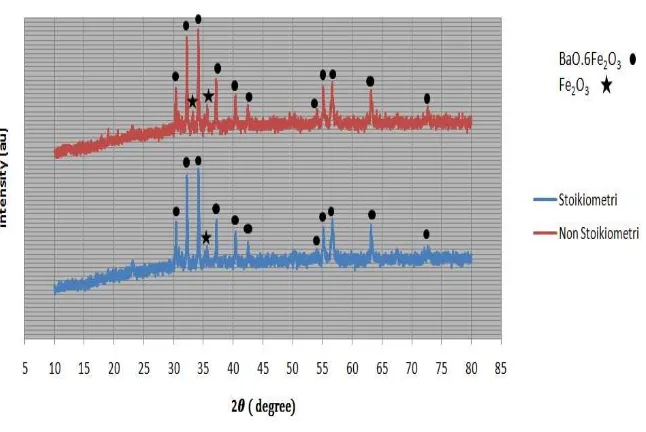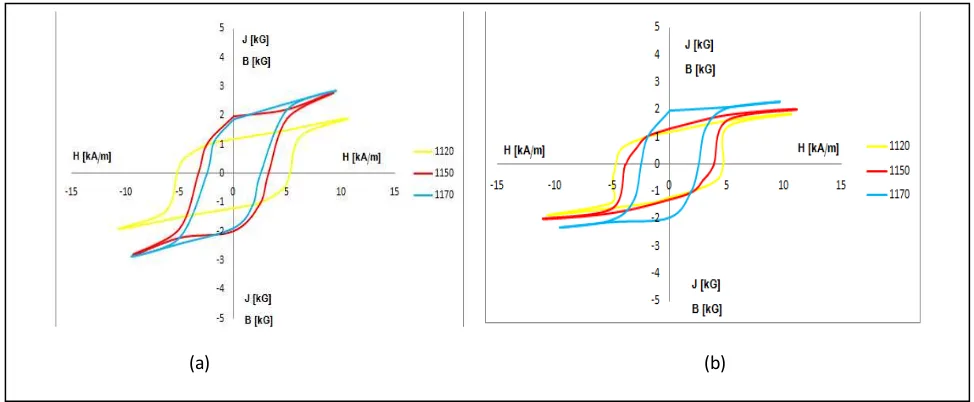(IJSBAR)
I SSN 2 3 0 7 - 4 5 3 1
(Print & Online)
http://gssrr.org/index.php?journal=JournalOfBasicAndApplied
---
224
The Effect of Composition and Sintering Temperature on
Magnetic Properties of Ba-Hexaferrite
Syahrul Humaidi
a*, Aditia Warman
b, Kharismayanti
c, Perdamean S
d, Prijo S
ea,b,cDepartemen Fisika, Fakultas Matematika dan Ilmu Pengetahuan Alam, Universitas Sumatera Utara Jalan
Bioteknologi No.1 Kampus USU, Medan 20155, Indonesia
d,ePusat Penelitian Fisika, Lembaga Ilmu Pengetahuan Indonesia (LIPI) Kompleks Puspiptek Serpong,
Tangerang Selatan 15314, Indonesia
aE-mail: [email protected]
Abstract
The hard magnetic Barium Hexaferrite was made from BaCO3 and Fe2O3 powders at various compostions of
BaCO3 and Fe2O3 with stoichiometric ratio of 1:6 and non-stoichiometric ratio of 1:6.5. The preparation was
done by wet mixing and grinding using PBM. The powder was calcined at 1000oC for 2 hours and subsequently
being analyzed using XRD to observe the structure of BaO.6Fe2O3. The powder was then sieved to pass 400
mesh (38 µ m) followed by the addition of 3wt% printing Seluna as an adhesive. The printing was done by using
a magnetic anisotropy field press and pressurized at 5 tons at a temperature of: 1120oC, 1150oC, and 1170oC for
2 hours respectively. The results showed that the non stoichiometric ratio was better than a stoichiometric ratio.
A magnetic field strength of 544.2 Gauss with a density = 4.0 g/cm3, porosity = 4.06%, Remanence (Br) = 1.72
kG, Coercivity (HcJ) = 2.41 kOe, and Energy product (BH max) = 0.63 MGOe were achieved when the magnet
sintered at 1170oC. It was found that the addition of 0.5-mole% Fe2O3 enhanced the density of the magnet.
Keywords: Hard Megnetic; BaO.6Fe2O3; XRD; calcined.
---
225
1.Introduction
A permanent magnet should be able to generate high magnetic flux of a given magnet volume, good magnetic
stability against the effects of temperature and time, and high resistance to demagnetization effects. In principle,
permanent magnet must have a minimum of the magnetic characteristics: high remanence (Br), high intrinsic
coercivity (Hc) and high Curie temperature (Tc) [1]. A composite magnet based on ferrite has a wide
application [2,3]. It is known that Barium hexaferrite is one of the most promising materials for high-density
magnetic material due to their unique magnetic characteristics, namely, high coercivity, moderate magnetic
moment, low or positive temperature coefficient of coercivity, and high chemical stability
Barium Hexaferrite of type-M, which is better known as hexagonal barium ferrite (BAM) is a ceramic oxide
and most widely used commercially and has been chosen as a material research to develop in terms of practical
use until today. Barium Hexaferrite is an anisotropic magnetic material with a high field [4]. Hence, it can be
used at a higher frequency than the ferrite spinel or garnet (above 30 GHz). Anisotropic magnetic crystals were
obtained from crystal with high anisotropic structure. The crystal structure of the grain growth is also
anisotropic, with hexagonal morphology as areas that provide improved anisotropic. As a result, BAM produces
high coercivity. Many techniques [5-7] have been developed as well as the addition of doping have been added
in [8-9] to the precursor. In this research, we tried to investigate the effect of preqursor composition. In the first
composition, we made a normal ratio of 1:6, whilst another composition we made with a ratio of 1:6.5. By
addition of 0.5-mole% Fe2O3, we hope an enhancement either in physical properties or magnetic properties.
2.Experiment procedure
In this study, a permanent magnet Barium Hexaferrite was made by using the powder metallurgy method by
combination of some oxide in powder form (milling process), calcinations, compaction and sintering. The raw
materials used were BaCO3 and Fe2O3 (technically raw). In the first route we combine: BaCO3 + 6Fe2O3 to
produce BaFe12O19, whereas in the second route we combine : BaCO3 + 6.5Fe2O3 to produce BaFe12O19. The
powder was then mixed by using a Planetary Ball Milling (PBM) in wet milling for 20 hours. The powder was
then dried at 100oC for 24 hours. The dried powder had been sintered at 1000oC before grinded by using a
mortar to pass a particle size of 400 mesh (38 µm). A pressure of 5 ton with anisotropic compacting was applied
to form a pellet (by adding 3% Seluna WE - 518 of Barium Heksaferrite) with diameter of 5 cm and 2 mm in
thickness. The pellet was then sintered at: 1120oC, 1150oC and 1170oC in an electrical furnace for 2 hours
respectively. The sintered pellet was then characterized in order to determine the physical and magnetic
properties. Phase identification was performed by X-ray powder diffraction (XRD) method with Cu Kα
radiation with 2Ɵ=10o to 80o. The pellet flux density was measured by using a Gaussmeter whereas BH curve
was obtained by using Permagraph.
3.Results and discussion
The XRD pattern as shown in figure 1 was used in the determination of the major and minor phase occurence
226
Figure 1: X-ray diffraction pattern of permanent magnet Barium Hexaferrite
From Figure 1, it can be seen that the major phase is Barium Hexaferrite (BaO.6Fe2O3) and the minor phase is
Hematite (Fe2O3). In the composition of 1:6, it was found that 90.9% of (BaO.6Fe2O3) phase occurred at 816oC,
whilst 9.1% of Hematite (Fe2O3) was observed. On the other hand, the composition of 1:6.5 indicates that
80.8% major phase was Barium Hexaferrite (at 810oC) with 18.2% Hematite phase. The graph shows the first
four maximum peaks occur at 30o< 2Ѳ < 40o. This implies that the characteristic peaks corresponding to the
barium hexaferrite structure as a major phase. This confirms the complete conversion of the precursor powder
into BaFe 12
O 19
[10].
Figure 2 below shows that the increasing in sintering temperature causes the density values (bulk density) tend
to increases due to diffusion process, and sintering temperature may result in enhancement of grain growth so
that the pores among the grains can be reduced more and more. The greater shrinkage occurs when the sintering
temperature increases causing the flux density increases as the bonding among the particles are getting stronger.
227
Figure 3: The effect of sintering temperature on the flux density
From Figure 3 above, it can be seen that the addition of raw materials of 0.5% Fe2O3 (% mol) of stoichiometric
calculations can increase the magnetic field strength. A value of 508.10 gauss in magnetic field strength
(stoichiometric) and 544.20 gauss in non-stoichiometric were obtained at 1170oC. This is due to fact that only
the Fe3+ ions have a magnetic property and a densification of the magnet at this temperature. However, the
obtained magnetic field strength is less than previous finding. Sudirman et al. [11] reported a range of
(765-1072) gauss can be achieved by addition of coupling agent 3-APE. The difference might be due to the sample
preparation as well as the addition of the coupling agent. The hysteresis curva of the magnet as can be presented
in below Figure 4.
Figure 4: Hysteresis curve of 1 : 6 composition (a) and a composition of 1 : 6.5 (b)
228
From Figure 4 it can be seen that the BH curve has a significant narrowing of the curve that indicates the
decreasing of coercivity and increasing of magnetic remanence. The result of physical and magnetic properties
is shown in below Table 1 and Table 2 respectively.
Table1: Physical properties of BaO.6Fe2O3
Sintering
From Table 1, it can be seen that a little enhancement in porosity as well as density was achieved with
composition of 1: 6.5. If the comercial Ba-ferrite has a density of 5.1 g/cm3 [12], then this ratio at sintering
temperature of 1170oC is reasonable to be developed to a specific purpose.
Table2: Magnetic properties of BaO.6Fe2O3
Sintering
From Table 2 above, it can be seen that a maximum remanence value was obtained when the magnet sintered at
temperature 1700oC (1: 6.5) is around 1.72 kG with a coercivity value of 2.418 kOe and energy product value of
0.63 MGOe. According to Prijo Sarjono et al. [13], a permanent magnet in water flow meter application should
have a value of remanence (Br) = 2.45 kG, coercivity (Hc) = 135.2 kA/m (1.7 kOe) and energy products
(BHmax) = 1.13 MGOe. Thus, this composition is still reasonable to be explored in the future since its
229
commercial Ba-ferrite [12].
4.Conclusion
We compared the magnetic properties of Barium Hexaferrite by means of the precursor ratio. The phase
occurence has been formed at lower temperature with a composition of 1: 6.5. The addition of 0.5-mole% Fe2O3
in this composition can be used as a densification agent. The optimum physical properties as well as optimum
magnetic properties were achieved when this composition had been sintered at 11700C.
5.Recommendation
The composition of 1:6.5 can be referred as a nominal starting composition in the future work. The enhancement
in physical as well as magnetic properties would be achieved by using nanosized Barium Hexaferrite powders
and will be presented elsewhere.
Acknowledgement
We thanks to the researchers staff and assistants of Material Department, Laboratorium Rekayasa Material,
PPF-LIPI, Jakarta, for the assistance, materials and equipment facilities during the experiment.
References
[1]. Prijo Sarjdjono, Wisnu Ari Adi, Perdamaian Sebayang and Muljadi, Indonesian Journal of Materials
Science, vol. 13, no 2, pp. 146-152, February 2012.
[2]. Purwo Jatiutoro, Agus Yulianto and Satria Bijaksana, Indonesian Journal of Materials Science, pp.
167-169, October 2000.
[3]. Priyono and Azwar Manaf, Indonesian Journal of Materials Science, vol. 11, no 2, pp. 75-78, February
2010.
[4]. Novrida Idayanti and Dedi , Indonesian Journal of Materials Science, vol. 5, no 1, pp. 34-38, October
2003.
[5]. Priyono K and Azwar Manaf, Indonesian Journal of Materials Science, Special Edition, pp. 144-147,
October 2007.
[6]. Didin S. Winatapura, Deswitan, M. Toifur and Ridwan, Indonesian Journal of Materials Science, vol.
14, no 3, pp. 173-178, April 2013.
[7]. Ridwan, Akmal Johan, Mujamilah and Wisnu Ari Adi, Indonesian Journal of Materials Science, vol. 7,
230
[8]. Ridwan, Grace Tj. Sulungbudi and Mujamilah, Indonesian Journal of Materials Science, vol. 7, no 2,
pp. 5-9, February 2006
[9]. Sugik S, Sudirman, Aloma K. K., Indra G., Ari Handayani and Anik S., Indonesian Journal of Materials
Science, Special edition, pp. 170-173, October 2007.
[10]. T. Koutzarova, S. Kolev, Ch. Ghelev, D. Paneva and I. Nedkov, phys. stat. sol. (c) Vol. 3, pp. 1302,
2006.
[11]. Sudirman, Sugik S., Aloma Karo-karo, Deswita, Ari Handayani and Anik S., Indonesian Journal of
Materials Science, Special edition, pp. 162-166, October 2007.
[12]. Agus Yulianto, Indonesian Journal of Materials Science, vol. 8, no 3, pp.39-41, June 2007.
[13].Priyo Sardjono, Agus Sukarto, Perdamean Sebayang, Masbah RT Siregar, Nanang S, Azwar Manaf,

